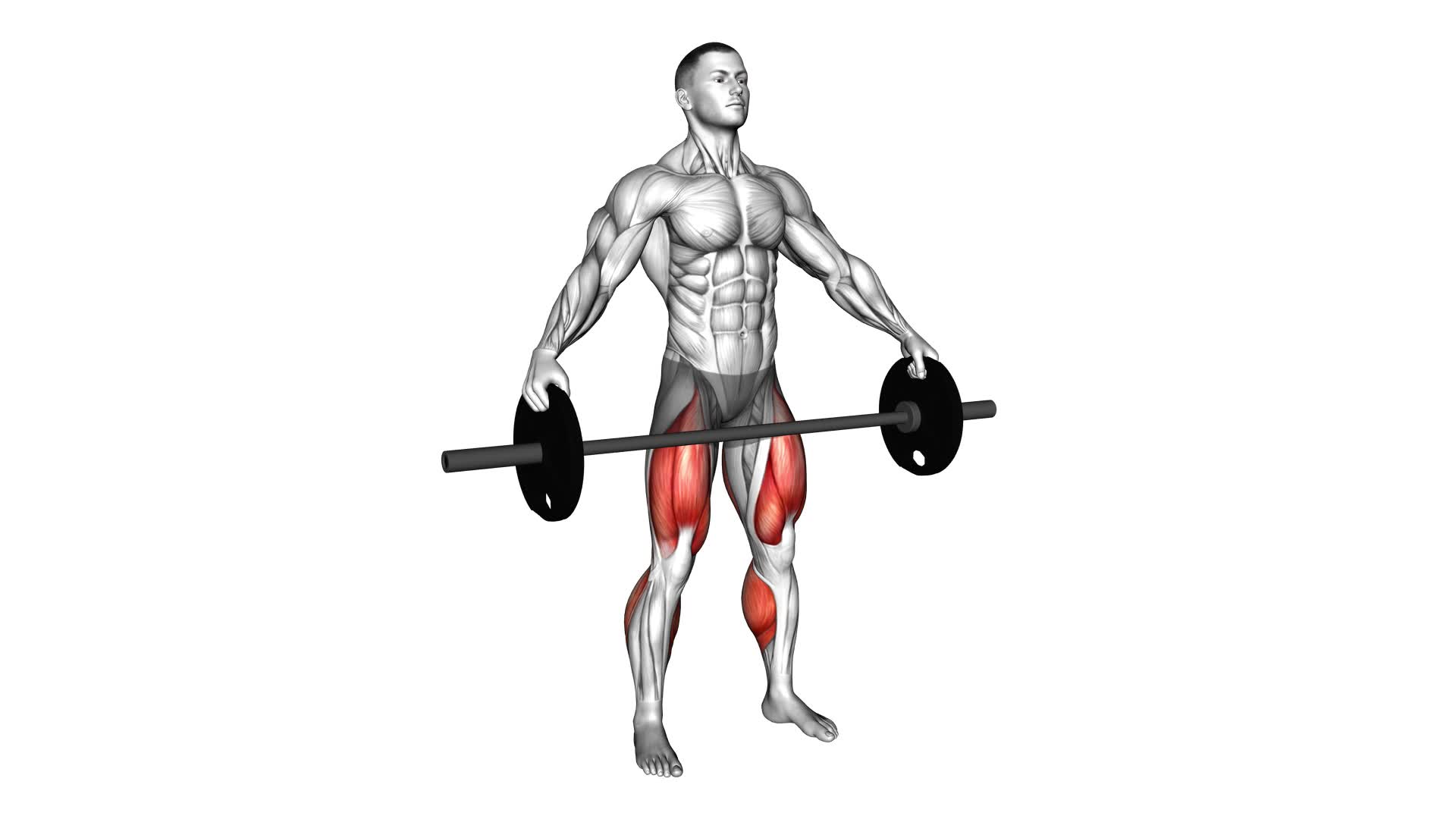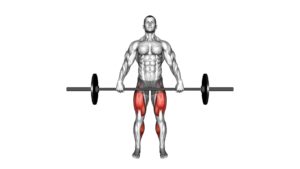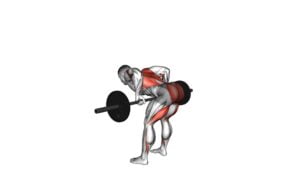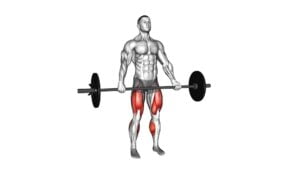Barbell Reeves Deadlift (male) – Video Exercise Guide & Tips

Are you looking to improve your deadlift technique and target specific muscle groups?
Watch This Exercise Video
Look no further than the Barbell Reeves Deadlift. In this video exercise guide, you'll find everything you need to know about performing the Barbell Reeves Deadlift with proper form and technique.
Avoid common mistakes and maximize your results with these helpful tips.
Get ready to take your deadlifts to the next level and achieve your fitness goals.
Let's dive in!
Key Takeaways
- The Barbell Reeves Deadlift targets the glutes, hamstrings, quadriceps, and lower back muscles, leading to increased strength, improved posture, and enhanced muscle definition.
- It can be incorporated into different training routines and adjusted in terms of weight, repetitions, and sets to accommodate different fitness levels and objectives.
- Proper form and technique, such as maintaining a neutral spine, engaging the core, and using legs and hips instead of arms, are crucial for safety and effectiveness.
- Variations and modifications, such as starting with lighter weights, incorporating other deadlift variations, and targeting different muscle groups, can be used to progress and achieve desired results.
Benefits of Barbell Reeves Deadlift
The benefits of the Barbell Reeves Deadlift include increased strength, improved posture, and enhanced muscle definition. This exercise is highly effective in targeting multiple muscle groups, including the glutes, hamstrings, quadriceps, and lower back. One of the major advantages of the Barbell Reeves Deadlift is its versatility, as it allows for various variations and modifications to suit individual needs and goals.
When it comes to programming and progression, the Barbell Reeves Deadlift can be incorporated into different training routines. It can be used as a primary compound lift or as an accessory exercise to complement other movements. Moreover, it can be adjusted in terms of weight, repetitions, and sets to accommodate different fitness levels and objectives.
To maximize the benefits of the Barbell Reeves Deadlift, proper form and technique are crucial. It's important to maintain a neutral spine, engage the core, and keep the shoulders back throughout the movement. Additionally, starting with lighter weights and gradually increasing the load over time allows for safe and effective progression.
Proper Form and Technique
To perform the Barbell Reeves Deadlift with proper form and technique, focus on maintaining a neutral spine, engaging your core, and keeping your shoulders back throughout the movement. This exercise involves lifting a barbell from the floor to a standing position, targeting your glutes, hamstrings, and lower back muscles.
One common misconception is that you need to round your back during the lift. However, this can lead to injury. Instead, keep your back straight and hinge at the hips while maintaining a slight bend in your knees.
Another key point is to avoid using your arms to lift the weight. Instead, use your legs and hips to generate the force needed to lift the barbell.
Variations and modifications can be made based on your fitness level and goals. For beginners, it may be beneficial to start with a lighter weight or use dumbbells instead of a barbell. As you progress, you can increase the weight and incorporate other deadlift variations, such as the sumo deadlift or Romanian deadlift, to target different muscles.
Remember to always prioritize proper form and technique to maximize the benefits and minimize the risk of injury.
Targeted Muscle Groups
Engage your glutes, hamstrings, and lower back muscles during the Barbell Reeves Deadlift to target these specific muscle groups. The Barbell Reeves Deadlift is a variation of the traditional barbell deadlift that offers several benefits.
By incorporating this exercise into your workout routine, you can effectively strengthen and tone your glutes, hamstrings, and lower back muscles.
The deadlift is a compound exercise that engages multiple muscle groups simultaneously, making it a highly effective exercise for building strength and muscle mass. However, different variations of the barbell deadlift can target specific muscle groups to a greater extent. The Barbell Reeves Deadlift is particularly effective at targeting the glutes, hamstrings, and lower back muscles.
The glutes, or buttocks muscles, are heavily engaged during the Barbell Reeves Deadlift as they work to extend the hips and maintain stability. The hamstrings, located at the back of the thighs, are responsible for hip extension and knee flexion. The lower back muscles, including the erector spinae and multifidus, are also activated during this exercise to maintain proper posture and stability.
Incorporating variations of the barbell deadlift, such as the Barbell Reeves Deadlift, into your workout routine can help you achieve a well-rounded lower body workout. By targeting specific muscle groups, you can enhance muscle strength, improve muscle definition, and increase overall athletic performance.
Common Mistakes to Avoid
Avoid these common mistakes when performing the Barbell Reeves Deadlift to ensure proper technique and maximize your results.
- One common mistake is rounding your back during the lift. This puts excessive strain on your spine and increases the risk of injury. Instead, maintain a neutral spine by engaging your core and keeping your chest lifted throughout the movement.
- Another mistake is using your arms to lift the barbell instead of relying on your legs and hips. This can lead to muscle imbalances and decrease the effectiveness of the exercise. Remember to drive through your heels and use your glutes and hamstrings to initiate the lift.
- Additionally, avoid locking out your knees at the top of the movement. This places unnecessary stress on your joints and can lead to discomfort or injury. Instead, maintain a slight bend in your knees to keep tension on your muscles.
By avoiding these common mistakes and focusing on proper technique, you'll be able to perform the Barbell Reeves Deadlift safely and effectively.
Now, let's move on to some tips for maximizing your results.
Tips for Maximizing Results
Looking to achieve optimal results with the Barbell Reeves Deadlift? How can you effectively enhance your performance and maximize your gains? Here are some tips to help you get the most out of this exercise:
- Start with proper form: Before adding weight, focus on mastering the correct technique. This will ensure that you engage the right muscles and reduce the risk of injury.
- Gradually increase weight: To maximize gains, progressively overload your muscles by gradually increasing the weight you lift. This will challenge your muscles and promote strength and muscle growth over time.
- Incorporate variations: Don't be afraid to mix things up. Incorporating different variations of the Barbell Reeves Deadlift, such as sumo deadlifts or deficit deadlifts, can target different muscle groups and help prevent plateaus.
- Prioritize recovery: Remember that progress happens outside of the gym too. Make sure to prioritize rest and recovery, as this is when your muscles repair and grow. Aim for adequate sleep, proper nutrition, and active recovery strategies like foam rolling and stretching.
Frequently Asked Questions
How Many Sets and Repetitions Should I Perform With the Barbell Reeves Deadlift?
To get the most out of the barbell Reeves deadlift, it's important to know how many sets and repetitions to perform. Different variations of this exercise can target specific muscle groups.
To avoid injury, it's crucial to learn the proper form and technique. So, how many sets and reps should you do? It's recommended to start with 3-4 sets of 8-12 repetitions, gradually increasing the weight as you get stronger.
Listen to your body and adjust accordingly.
Can I Incorporate the Barbell Reeves Deadlift Into My Leg Day Routine?
Yes, you can definitely incorporate the barbell Reeves deadlift into your leg day routine. This exercise offers several benefits for leg strength. By incorporating it into your routine, you can target multiple muscles in your legs, including your quadriceps, hamstrings, and glutes.
It also helps improve your overall stability and balance. Adding the barbell Reeves deadlift to your leg day routine can help you achieve a well-rounded lower body workout.
Is the Barbell Reeves Deadlift Suitable for Beginners or Is It More Advanced?
The barbell Reeves deadlift is more advanced due to its focus on targeting specific muscles and requiring proper form. However, it can still be beneficial for beginners who are looking to improve their strength training routine.
This exercise can help build lower body strength and improve overall posture. It's important to avoid common mistakes such as rounding the back, using too much weight, or not engaging the core properly.
Focus on proper form and gradually increase the weight as you progress.
Can I Use Dumbbells Instead of a Barbell for the Reeves Deadlift?
Yes, you can use dumbbells instead of a barbell for the Reeves Deadlift.
Using dumbbells can offer a great alternative to the barbell, as it allows for a wider range of motion and targets your muscles in a slightly different way.
It can also help improve your grip strength.
However, keep in mind that dumbbells may not offer the same level of resistance as a barbell, so you may need to increase the weight to challenge yourself.
Are There Any Modifications or Variations I Can Try to Target Different Muscle Groups With the Barbell Reeves Deadlift?
To target different muscle groups with the barbell Reeves deadlift, there are several modification options you can try.
One option is to change your grip on the barbell, such as using an overhand grip instead of an underhand grip.
Another option is to vary the width of your stance, either by placing your feet closer together or wider apart.
These modifications can help engage different muscles, such as the back, glutes, and hamstrings, for a more well-rounded workout.
Conclusion
In conclusion, the Barbell Reeves Deadlift is a beneficial exercise that targets multiple muscle groups. By maintaining proper form and technique, you can maximize your results and avoid common mistakes.
Remember to focus on engaging your glutes, hamstrings, and lower back while performing this exercise. With consistent practice and attention to detail, you can effectively strengthen your posterior chain and improve overall strength and stability.

Author
Years ago, the spark of my life’s passion ignited in my mind the moment I stepped into the local gym for the first time. The inaugural bead of perspiration, the initial endeavor, the very first surge of endorphins, and a sense of pride that washed over me post-workout marked the beginning of my deep-seated interest in strength sports, fitness, and sports nutrition. This very curiosity blossomed rapidly into a profound fascination, propelling me to earn a Master’s degree in Physical Education from the Academy of Physical Education in Krakow, followed by a Sports Manager diploma from the Jagiellonian University. My journey of growth led me to gain more specialized qualifications, such as being a certified personal trainer with a focus on sports dietetics, a lifeguard, and an instructor for wellness and corrective gymnastics. Theoretical knowledge paired seamlessly with practical experience, reinforcing my belief that the transformation of individuals under my guidance was also a reflection of my personal growth. This belief holds true even today. Each day, I strive to push the boundaries and explore new realms. These realms gently elevate me to greater heights. The unique combination of passion for my field and the continuous quest for growth fuels my drive to break new ground.







